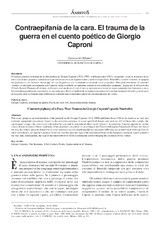Contraepifanía de la cara. El trauma de la guerra en el cuento poético de Giorgio Caproni
Autor
Alfano, Giancarlo
Editor
Asociación de Estudios de Ciencias Sociales y HumanidadesFecha
2014Materia
Giorgio CaproniLiteratura de guerra
Poesía del siglo XX
Representación del trauma
War literature
XXth Century Poetry
Representation of Trauma
METS:
Mostrar el registro METSPREMIS:
Mostrar el registro PREMISMetadatos
Mostrar el registro completo del ítemResumen
El ensayo propone la lectura de la obra poética de Giorgio Caproni (1912-1990) –publicada entre 1956 y su muerte– como si se tratase de un único cancionero perpetuo, centrado en la presencia recursiva de algunos temas y motivos específicos. Todo ellos, como el «viento», la «página del periódico» o el «rostro», tienen que ver con la guerra y con su traumático recuerdo en el yo poético. Más particularmente, el tema del «rostro» es utilizado asiduamente por Caproni, hasta covertirlo en emblema central de ese cancionero perpetuo. Siguiendo la reflexión del filósofo francés Emmanuel Lévinas, si el rostro es el modo en el cual el otro se presenta ante nosotros como semejante (ser humano) y en su diversidad (algo diferente a nosotros), se convierte por ello en el símbolo de la ruptura traumática del contínuo temporal del antes y el después de la guera, ante la evidente imposibilidad de construir una comunidad a partir del reconocimiento del «otro». This essay proposes an interpretation of the poetical works Giorgio Caproni (1912-1990) published from 1956 to his death as an only and coherent «perpetual canzoniere» based on the recursive presence of some specifical themes and motives. All of these (the «wind», the «newspaper’s page», the «face») are referred to the war and its traumatical effect on the lyrical I. In particular, Caproni appears to use the «face»-theme as a kind of basic «emblem» of his perpetual canzoniere: if, according to the French philosopher Emmanuel Lévinas, the face is the way the «other» presents himself to us in his similarity (as a human being like us) and in his difference (as an individual differing from all other individuals), in Caproni’s poetical works the face becomes the sign of the traumatical brake in the temporal continuity before and after the war, and, consequently, the sign of the impossibility to form a community acknowledging the existence of the «other»

